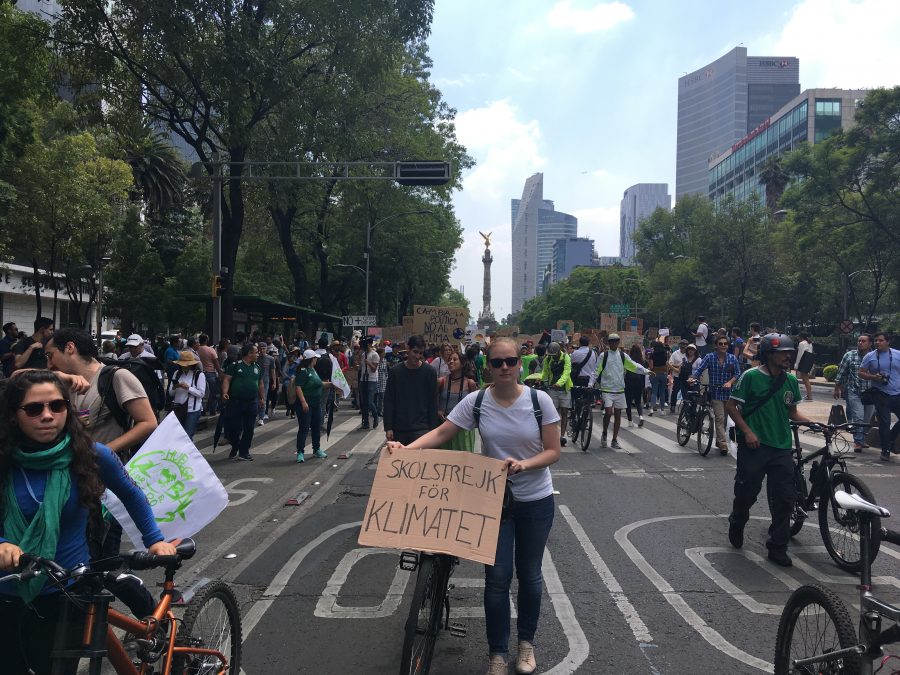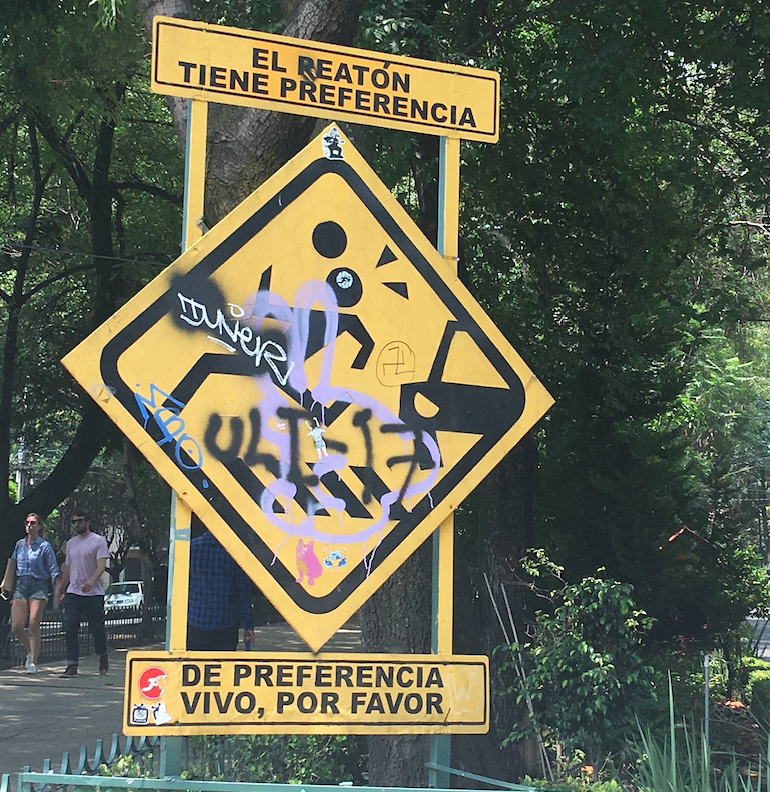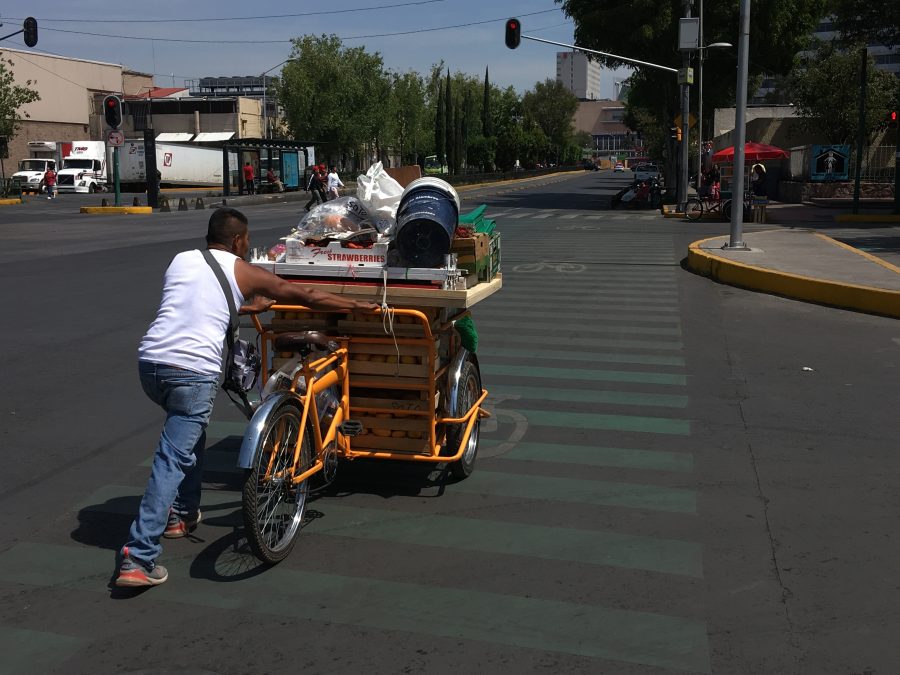11 min. read
Paola Castañeda is PhD student at the Transport Studies Unit of the University of Oxford, researching activist practises in relation to mobility in Latin America. She completed an MPhil in Geography and the Environment at the University of Oxford and holds a BA in History from the Universidad de los Andes (Colombia).
How did you become involved in cycling activism and what are your current research interests?
I’m a geographer and a historian, and when I started my masters in geography at Oxford, I had planned a research project around something else entirely for which I’d gone back to Bogotá. Suddenly, I found a group of cyclists, what in the North would be known as a critical mass ride, which in Bogotà is called a rodada. It was just a watershed moment in my life. I realised that there’s something amazing going on here, and felt compelled to do my research about it.
It’s often the case that people who go into academia to do research about cycling were involved in cycling organisations but for me it was the contrary: it was through academia that I realised how much potential there was to do and think in these groups. I approached cycling organisations first in Bogotá through my masters degree and then for my PhD I looked at cycling organisations in Santiago, Chile, and in Mexico City. I also participated and helped people organise some activities in the World Bike Forum.
Ultimately, I feel situated halfway in between academia and the world of activism because at the end of the day, my project is concerned in how people know things, and how people mobilise the bike. For me it’s important that what I work on ends up feeding back into these movements and being helpful for the movement. I don’t just want to tell a story about the way things are, I want to tell a story about how things can be, and the different possibilities that exist.
My research interests are thus very connected to knowledge, how knowledge travels, and how people who are traditionally not considered to be experts come to know this topic so well. I’m also interested in mobility justice. It’s a theme I picked up during my research and while it’s not featured primarily in my dissertation, I tried to develop some initiatives with people around it in Chile which is very rewarding. Throughout the course of my research, I became very interested in the question of gender and cycling, but not just how to get more women cycling but how these different constructions of both gender and cycling come about.
Can you maybe briefly define mobility justice in your own words and contextualise its relatively recent development?
Mobility justice is really interesting as its development has occurred in a parallel manner. On the academic side with Mimi Sheller’s book Mobility Justice and on the grassroots side by The Untokening and people in that circuit of discussions.
To me, mobility justice is perhaps more of a perspective rather than an approach to thinking about mobilities: a framework to read how mobility and immobility both produce, reproduce and also reflect asymmetries in power relations. It goes beyond urban transportation, framing mobilities as a broader way of engaging with the world: the idea that mobility, motion and movement are so central to how we develop our subjectivity, to how we relate to the world and to how we as people are circumscribed in what we can and cannot do in the world.
The value of what Mimi Sheller is proposing is being able to connect different scales together through the lens of mobility and how justice matters in three crises. She talks about the climate crisis, which is obviously a crisis of mobility, in so much as how we move and the intensification of movement bring about all of these effects, and obviously climate and the Earth as something vital in our lives. Then she talks about migration, the reasons and conditions of it. The third crisis is one of urban mobility, something that we are all very much in touch with when we live in cities. The majority of urban experiences are related to traffic collapse and immobility, so mobility justice can help understand who bears the burden of these mobilities and why certain people are more able to move more quickly and in better conditions than others, and how that’s related to issues of race, issues of class and gender.
Then of course you have people like The Untokening who have a reading of mobility justice that comes from their own embodied experience as people of colour in the United States. How their experience with urban planners and everyday experience with cycling has led to a reflection about who is mobile or immobile, and what kinds of movements are read as appropriate depending on who you are, whether you are a woman or a trans woman, whether you’re Black or latino or latina. Crucially they have been able to tie that to the other forms of injustice that movements like Black Lives Matter have brought out to the surface. They are putting on the table the essential conservation about why race matters when we talk about mobility.

You were involved in translating Untokening’s Principles of Mobility Justice, in order to make them resonate to the Latin American context. How did this process unfold?
As I have said before, one of my concerns with research is how do I make this useful to people, and I thought mobility justice actually articulates a lot of the concerns I had heard people talking about. In putting a label to them and bringing in really rich developments that people elsewhere had done I thought it would be very helpful to help articulate either a new discourse or articulate older discourses in Latin American activism and on that point I am still very close to the activists, cycling activists in Chile.
So we talked about bringing this vocabulary and this perspective into ongoing conversations. The challenge is that while these issues are transnational, they play out differently in different parts of the world, and people engage with them differently. How to bring these concerns that are rooted in a very specific experience in the US to Latin America where other concerns come to the fore and others fade into the background was very difficult. We first had to identify where to focus. The Untokening is focused on race, yet here Latin American race relations are very different: the very violent process of colonisation and mixing that took place in Latin America means that we have a very different racial markup and issues of class in Latin America come more to the fore when we talk about injustice.
In the end, what we decided to do was to bring in coloniality as one of the concerns into how we think about mobility justice in Latin America. Bringing that perspective allows us to talk about both how we relate racially but also how that becomes a question of class and concerns about gender also matter a lot here in different ways, in very specific ways.
So in addition to that, in the translation we wanted it to be an open document and an open project that people could feedback into, so we organised a bit of a space to have these discussions about how these ideas, how we can not just translate the world but how we can translate the sentiment and translocate the idea of mobility justice.

You have cautioned against universalising the experiences of European “cycling cities” and suggested that turning to cities of the global South can animate cycling research in promising new directions. Can you elaborate on this?
I’m currently in a moment of great dissatisfaction with the ways in which Latin American’s cycling has been ignored by scholars. The planning world is also broadly not engaging with the vocabulary of decolonisation. Maybe in some instances more academic planning, yes, but I’ve hardly seen it in practitioners.
Social movements in Latin America are increasingly adopting that vocabulary and perspective however. It makes me very glad to see Jimena Perez Marchetta, who’s the Bicycle Mayor of Salta, say “we don’t want to be Amsterdam, we want to be Salta in the 1970s”. I think that really captures the sentiment. We have these paradigmatic examples, but they look nothing like the cities of Latin America. You simply cannot compare cities like Mexico City to cities like Copenhagen, it’s absurd. Even the stereotypes that people have in their minds about what cycling advocacy is come from the global North, from the United States and from England. I think we need to pay much closer attention to the ways in which people organise their own cycling here. Thankfully, people are increasingly realising that we can rescue what we have here and leverage our own measures for what a cycling city looks like.
The first question to ask is why these are the standards and the measures that we should aspire to. The second is why a lot of the richness of the cycling histories, traditions, cultures and uses of cycling in Latin America have been buried under a set of standards from abroad of what cycling cities look like. I think this has a lot to do with questions of mobility justice: which mobilities are desirable and adequate and which kind of mobilities are not.
Throughout the 20th century, the discourse of modernisation brought in auto-mobility and so these cycling mobilities that were really extensive here came to be marginalised and faded into the background. They, however, persisted and today people like Claudio Sarmiento are doing a really great work about, for example, what he calls bicioficios, cycling trades in Mexico. Why are these things not more prominent? Why are we seeing so much scholarship coming from Europe about cargo bikes, freight transport on bicycles, and making that our model of aspiration rather than looking at all of these different adaptations and uses that we had historically here?
Cities like Bogotá obviously and Mexico City that have these very rich cycling cultures but, unfortunately, a lot of the times the success gets measured by how many kilometres of cycling infrastructure you have, or, you know, the latest policy document on cycling. People have wrongly assumed that people in latin American cities don’t cycle. But people do cycle, they just cycle at the margins. This creates a situation where a lot of users of the bicycle continue to be invisibilised by certain metrics and certain aspirations.

You have been a participant observer in the bike activism scene in Bogotá, developing a framework that you call the Right to the Mobile City. How do certain kinds of mobilities help us move from the right to mobility towards a right to the mobile city?
Bogotá has been branded as la “Capital Mundial de la Bici”, but a lot of activists say that it actually is la “Capital Mortal de la Bici”! This says a lot about the dissonance between the standards that planners aspire to and the realities that people live out on the streets.
I found it so interesting that a city that brands itself as the global capital of cycling would have such a widespread, diverse cycling activist movement. A stereotype that has developed on the basis of analysing cycling advocacy movements in the global North is that they represent middle class groups with bourgeois interests but what I found in Bogotá is that you have cycling collectives across the city, with clearly something more than a bourgeois interest in having a great cycling city.
Through conversations, it became apparent that their claims weren’t simply about having more or a better infrastructure, it was about recovering the right to the city. It was about bringing about the city of one’s desires into being, even if momentarily. In those moments, you can see what happens when you de-commodify urban space, when you resignify the different infrastructures of the city and you explore what the body is able to do with them when its capacities are extended by a bicycle. When people start thinking about the right to the city and its relationship to mobility, the ability to access services and amenities of the city in order to participate in it comes up a lot, but that overlooks that moving through the city is one of the fundamental ways in which we experience the city itself.
So, the right to the city should also, in my view, consider the ways in which movement brings worlds into being and I think that’s a great way to connect mobility justice. The importance of movement in shaping who we are in relation to the city, allowing for the city to be a place of exploration. This idea of the mobile city, the right to produce the city on the move in a way that is different from the model of auto-mobility, that segregates spaces for movement and doesn’t leave room for people to realise the extent of their capacities but also collectively in the city. The bicycle on the other hand, facilitates conversations, community building and experimentation with alternative ways of organising ourselves economically.

